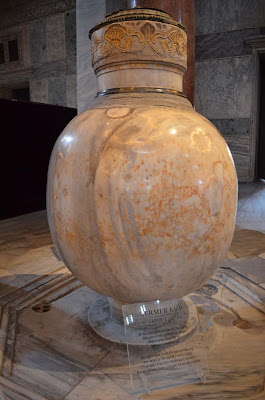 |
- The word "Pharaoh" is a title meaning: "The Great One of the House"
- "Pharo" - King, and "Ah" - House"
- Cleopatra the 7th was the last ruler of Egypt
- Apparently she was a very ugly woman with a very large nose (that's how she's depicted on the coin)
Now, the Romans did hate the Egyptians, so it is possible that they minted it badly on purpose, but, if they really did hate her that much, they would not have minted her face at all
- Doctors all over the world write: Rx
- This is Egyptian in origin. The eye of Horus is the R, and it is the symbol of knowledge
- The Romans had no respect for Egyptian culture.
- When the Romans became Christians, they stopped the Egyptians from using their language and their Temples, and slowly, the Egyptians started losing their culture.
- This actually prepared the way for Islam to come in.
- Egypt is called Kamet, which means "Black Land". Kamet became Gemet, which became Coptic
- The Coptic Church is the oldest church in the world
Q: Why is the cobra featured prominently on the Egyptian crown?
A: The cobra is an ancient symbol of protection for the ancient Egyptians.
Legend has it that Horus lost his eye, and he replaced it with a cobra. When the eye was restored, he moved the cobra to his forehead. (Incidentally, this was the start of the legend of the third eye)
Notes on Jerusalem (These are from our guide "Mickey")
Some Phrases:
- Sababa - "Cool!"
- Shorodi - Services (as in hotel services)
The best part about being Seventh-day Adventist in Jerusalem is that we can eat everything! :)
Q: Why do some people at the Western Wall wear great big fur hats? (even in summer)
A: "If you can survive a fur hat in the summer, you've got to be holy!"
Q: Why do many Jews dress in black and white?
A: "Black is for modesty, and white is for purity."
Q: What is the difference between East and West Jerusalem?
A: "East is Arabic-speaking" and the West is a mix of Arab Muslim, Arab Christian, Armenian Christian, and Jewish Christian"
Jews cannot figure out if "Jew" is a religion or a nationality =)
- The immigration law says that if you have quarter Jewish blood, you can be a citizen
- This is actually how the Nazis identified who is a Jew
- If you are 100% Jew, but become a Christian you cannot become a citizen in Israel
- If you are already a citizen and you become Christian you can stay
- There are 15,000 Christians living in Jerusalem (these are Messianic Jews)
- 75% of Jews in Israel are secular
- The majority of the Jesus are orthodox
- Copt / Gypsy are corruptions of the word "Egyptian"
- Hasidic Jews are named based on a corruption of the word "Hesed" - meaning Kindness, Loyalty, Devotion, Steadfast Love
- This is where "Bethesda" comes from. ("Beth" house, and "Hesed" mercy")
Notes on Turkey (These are from our guide Attakan)
Some Phrases:
- Hoshgadenesh - "Welcome!"
- Merhaba - "Hello"
- Teshequeir Ederim - "Thank you"
Sagl (pronounced "Saow") - "Thank you"
Turkey is not an Arab country, even though the West think that
- Turks and Arabs are Muslim, but that's all they have in common
- The homeland of the Turks is central Asia near Mongolia, and the people have many similarities with Koreans
When Mustafa Kefal Ataturk took power he
- outlawed polygamy
- enforced a separation of Religion and State
- It was a Muslim republic before, but now it's a secular state. This means that the state *cannot* have a religion, even if the people do. (So basically, anyone working for the government: teachers, police, etc. cannot wear any religious symbols when they are doing their job)
- outlawed sharia law courts
- adopted a new written alphabet. (Back in 1923 everything was in Arabic. Today, it's all in Latin characters) This helped increase the level of education and get rid of the Muslim influence.
- The issue before was that many Muslims would recite the verses from the Qur'an that they needed to recite without understanding what was being said. (The Catholics used to do the same thing when the services were in Latin)
- changed the holy day from "Friday" to "Sunday". He set up Friday as a work day.
- changed the calendar from the lunar calendar to the gregorian one
- set up things so that the metric system would be used.
Today, there are 7000 mosques in Turkey. However, the rule is that people should have total freedom of conscience to believe what they want to. The principle is "religion by oppression is not true religion"
- The Turks are very hospitable people so long as you don't try to convert them.
Many Islamic countries think that Turkey is a heretic country.
- They say that you cannot be democratic and Muslim at the same time.
- Turkey is trying to prove the opposite.
Some people say that Turkey is a bigger danger to Muslims than the Western world
- Jesus never claimed to be the leader of the State and the Army, but Muhammad was both the leader of the State and of the Army, hence, the Muslims follow the example of Muhammad
Today, 98% of the Turks are Muslims. The Christians in this area were Greek Orthodox, but in a decision for change, they decided to swap the Greek Muslims with the Turkish Greek Orthodox and let everyone return to their home countries.



















































